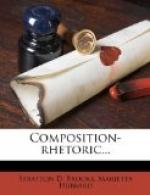+119. Order of Observation.+—In description we shall find it of advantage to use such language that the reader will form the image in the same way as he would form an image from actual observation. There is a customary and natural order of observation, and if we present our material in that same order, the mind more easily forms the desired image. Our first need in the study of description is to determine what this natural order of observation is.
Look at the building across the street. Your first impression is that of size, shape, and color. Almost instantly, but nevertheless secondly, you add certain details as to roof, door, windows, and surroundings. Further observation adds to the number of details, such as the size of the window panes or the pattern of the lattice work. Our first glance may assure us that we see a train, our second will tell us how many cars, our third will show us that each car is marked Michigan Central. The oftener we look or the longer we look, the greater is the number of details of which we become conscious. Any number of illustrations will show that we first see the general outline, and after that the details. We do not observe the details one by one and then combine them into an object, but we first see the object as a whole, and our first impression becomes more vivid as we add detail after detail.
Following this natural order of observation a description should begin with a sentence that will give the reader a general impression of the whole. Notice the beginnings of the following selections. After reading the italicized sentence in each, consider the image that it has caused you to form.
The door opened upon the main or living room. It was a long apartment with low ceiling and walls of hewn logs chinked and plastered and all beautifully whitewashed and clean. The tables, chairs, and benches were all homemade. On the floor were magnificent skins of wolf, bear, musk ox, and mountain goat. The walls were decorated with heads and horns of deer and mountain sheep, eagle’s wings, and a beautiful breast of a loon, which Gwen had shot and of which she was very proud. At one end of the room a huge stone fireplace stood radiant in its summer decorations of ferns and grasses and wildflowers. At the other end a door opened into another room, smaller, and richly furnished with relics of former grandeur.
—Connor: The Sky Pilot.
The stranger was of middle height, loosely knit and thin, with a cunning, brutal face. He had a bullet-shaped head, with fine, soft, reddish brown hair; a round, stubbly beard shot with gray; and small, beady eyes set close together. He was clothed in an old, black, grotesquely fitting cutaway coat, with coarse trousers tucked into his boot tops. A worn visored cloth cap was on his head. In his right hand he carried an old muzzle-loading shotgun.
—George Kibbe Turner: Across the State ("McClure’s").




